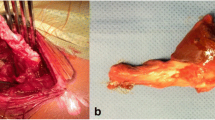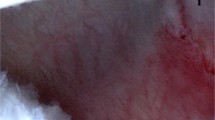Abstract
Objective. The purpose of this study was to review the normal and sonographic (US) anatomy of the central aponeurosis of the rectus femoris muscle, describe the sonographic appearance of its tears and correlate it with the MR findings.
Design and patients. The rectus femoris internal architecture was evaluated by cadaveric dissection. To correlate the sonographic normal findings with cadaveric data, axial sections were compared with the corresponding US images. The normal in vivo sonographic appearance of rectus femoris was assessed in 20 healthy subjects (40 thighs). To evaluate the US findings in central aponeurosis tears we performed a retrospective review of 17 examinations of 17 patients suffering from acute injuries. Follow-up examinations were available in five patients. Sonographic findings were correlated with MR findings in eight patients.
Results. Anatomical dissection of the rectus femoris confirmed the presence of the central aponeurosis, a sagittally oriented fibrous band located within the proximal two-thirds of the muscle belly. In vitro US showed the central aponeurosis as a curvilinear hyperechoic structure whose shape correlated well with the cadaveric data, and in vivo US demonstrated it in all healthy subjects. In the retrospective analysis of the patient group, we classified the lesions into three groups according to the size at sonography: group 1 (n=9), hyperechoic band surrounding an intact central aponeurosis; group 2 (n=7), mixed hypo- and hyperechoic bands surrounding an intact central aponeurosis but associated with globular enlargement of the rectus femoris; group 3 (n=1), complete discontinuity of the rectus femoris. These findings can reflect small partial tears, larger partial tears and complete musculotendonous junction tears respectively. In patients evaluated with both techniques, MRI confirmed the US findings. In five patients follow-up studies showed an irregular hyperechoic ill-defined area centred on the central aponeurosis that was compatible with a central scar.
Conclusions.Sonography can demonstrate the normal internal anatomy of the rectus femoris and post-traumatic changes at the myotendinous junction of the central aponeurosis. Sonographic data correlate well with MR findings, and the low cost and wide availability of sonography make it the first-line technique in the evaluation of injuries of the rectus femoris.
Similar content being viewed by others
Author information
Authors and Affiliations
Additional information
Electronic Publication
Rights and permissions
About this article
Cite this article
Bianchi, S., Martinoli, C., Waser, N. et al. Central aponeurosis tears of the rectus femoris: sonographic findings. Skeletal Radiol 31, 581–586 (2002). https://doi.org/10.1007/s00256-002-0559-z
Received:
Revised:
Accepted:
Issue Date:
DOI: https://doi.org/10.1007/s00256-002-0559-z




